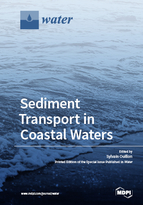Sediment Transport in Coastal Waters
A special issue of Water (ISSN 2073-4441). This special issue belongs to the section "Water Erosion and Sediment Transport".
Deadline for manuscript submissions: closed (30 June 2017) | Viewed by 111299
Special Issue Editor
Interests: sediment dynamics; sediment processes; watershed; estuaries; coastal oceanography; effects of climate change and human activity on sediment budget; ocean color in coastal waters and applications; numerical modeling
Special Issues, Collections and Topics in MDPI journals
Special Issue Information
Dear Colleagues,
Globally, while land erosion has increased in the last decades, sediment input to the ocean has decreased. Sediment transport and distribution at the land-ocean interface has huge impacts on morphodynamics of estuaries, deltas and coastal zones, on water quality (and related issues such as aquaculture), on navigation and harbor capability, on recreation areas, etc. Scientific objectives must be achieved to deepen our knowledge on processes based on field surveys, modeling, space observation or experiments in laboratory, to refine the sediment budget (bedload and suspension) between compartments, and to improve our observation and modelling capacities. Sediment transport which is mainly driven by varying dynamical forcings (currents, tides, wind, waves, turbulence, stratification, density currents, etc.) in the estuary, in the ROFI zone, on the shelf or in canyons may also be affected by chemical and biological processes. In this Special Issue, we invite scientists working on different aspects of sediment transport, in muddy, sandy or mixed environments, to share their most recent results and give reviews or examples encompassing different aspects of sediment transport in coastal zones at different scales. Papers may deal with water and sediment analysis (including Particle Size Distribution), modeling, and remote sensing.
Dr. Sylvain Ouillon
Guest Editor
Manuscript Submission Information
Manuscripts should be submitted online at www.mdpi.com by registering and logging in to this website. Once you are registered, click here to go to the submission form. Manuscripts can be submitted until the deadline. All submissions that pass pre-check are peer-reviewed. Accepted papers will be published continuously in the journal (as soon as accepted) and will be listed together on the special issue website. Research articles, review articles as well as short communications are invited. For planned papers, a title and short abstract (about 100 words) can be sent to the Editorial Office for announcement on this website.
Submitted manuscripts should not have been published previously, nor be under consideration for publication elsewhere (except conference proceedings papers). All manuscripts are thoroughly refereed through a single-blind peer-review process. A guide for authors and other relevant information for submission of manuscripts is available on the Instructions for Authors page. Water is an international peer-reviewed open access semimonthly journal published by MDPI.
Please visit the Instructions for Authors page before submitting a manuscript. The Article Processing Charge (APC) for publication in this open access journal is 2600 CHF (Swiss Francs). Submitted papers should be well formatted and use good English. Authors may use MDPI's English editing service prior to publication or during author revisions.
Keywords
- sediment transport processes
- sediment budget
- suspension
- bed load
- estuaries
- coastal zones
- river plume
- nearshore processes
- numerical modeling
- remote sensing






